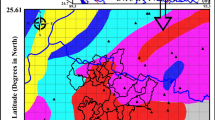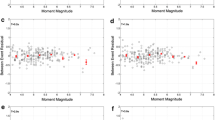Abstract
The active faults near Tehran are capable of producing Mw magnitudes of 6.62–7.23; at epicentral distances of 25 km from the active faults, and Mw = 7.23, the peak ground horizontal acceleration, PGH, is between 386 and 730 cm/s2 and peak ground vertical acceleration, PGV, is between 192 and 261 cm/s2; the historic earthquake of the fourth century BC, Mw = 7.16 produced the highest estimated PGH acceleration in Tehran, between 254 and 479 cm/s2 and PGV acceleration between 127 and 173 cm/s2. Earthquakes from 1909 to 2008, within 300 km from Tehran, are used for calculation of magnitude frequency relation, and results are applied to estimate PGH and PGV accelerations as a function of magnitudes for a set of fixed epicentral distance and site conditions; also as a function of epicentral distances for a set of fixed magnitudes and site conditions. Poisson’s distribution is used for probability calculation of PGH and PGV accelerations for several exposure times, site conditions and epicentral distances; accelerations with very high probability, near 1, are presented. At an epicentral distance of 10 km and exposure time of 450 years, in the northern part of Tehran, close to Mosha and the Northern Tehran faults, PGH acceleration is 800–420 cm/s2 and PGV is 400–220 cm/s2 with high probability. At an epicentral distance of 25 km and 1,000 years exposure time, PGH is 610–320 cm/s2 and PGV is 310–160 cm/s2 with high probability, where larger values are for soft soil and smaller values are for hard rock.


















Similar content being viewed by others
References
Ahmadi, G., Mostaghel, N., and Nowroozi. A. A. (1989), Earthquake risk analysis of Iran-V: Probabilistic seismic risks for various peak ground accelerations. Iranian Journal of Science and Technology 23 (2 & 3)
Ambraseys, N. N. and Melville C. P., History of Persian Earthquakes. (Cambridge University Press, Cambridge 1982)
Ashtari, M., Hatzfeld, D., and Kamalian, N. (2005), Microseismicity in the region of Tehran. Tectonophysics, 392, 193–298
Berberian, M. (1982), Pattern of historic earthquake rupture in Iranian Plateau. Bulletin of the Seismological Society of America 89, 120–139.
Campbell, K. W. and Bozorgnia, Y (2003), Updated near source ground motion (attenuation) relation for horizontal and vertical components of peak ground acceleration and acceleration response spectra. Bulletin of the Seismological Society of America 93, 314–331.
Castello, S. and Bormann P. (2007), Performance of different regression procedure on magnitude conversion problem. Bull seismological society of America. 94 (4), 1167–1175.
Castello, S., Mulargia, F., and Kagan Y. Y. (2006), Regression problems in magnitudes. Geophysical Journal International 165, 912–930.
Douglas, J. (2003), Earthquake ground motion estimation using strong motion records. A review of equations for estimation of peak ground acceleration and response spectra ordinates, Earth Sciences Review 6, 43–104.
Earthquake database of United States Geological Survey; National Earthquake Information Center, NEIC. (http://eqint.usgs.gov/neic).
Ghodrati, A. G. R, Razavian A. A. A., Motamed, R., Ganjavi, B. (2007), Uniform Hazard spectra for different Northern part of Tehran, Iran, Journal of Applied Sciences 7 (22), 3368–3380
International Center for Geohazard (2004), Bam earthquake of 26, December 2003, Reconnaissance Report, ICS, 2004.
Jackson, J., and McKenzie, D. (1984), Active tectonic of Alpine-Himalayan belt between western Turkey and Pakistan. Geophysical Journal of the Royal Astronomical Society 77,185–264
McGuire, R. K. (1993), Computation of seismic hazard, Annli Di Geofisica, XXXVI (3–4), 181–200.
Nateghi, F. (2001), Earthquake scenario for the mega-city of Tehran. Journal Disaster Prevention and Management 10, 95–101.
National Iranian Oil Co. (1978), Geological Map of Iran, Scale 1:1,000,000, compiled by H, Huber. Tehran, Iran.
Nazari H., Ritz J.-F., Salamati R. Solaymoni S. Balescu S., Michelot, J.-L., Ghassemi, A., Talabian, M., Lamothe, M., and Massaulut M. (2007), Paleoseismological analysis in Central Alborz. In 50th Anniversary earthquake Conference commemorating the 1957 Gobi-Altay earthquake (July–August 2007, Ulaanbaatar-Mongolia)
Newmark, N. and Rosenblueth, E., Fundamental of Earthquake Engineering (Prentice Hall, New Jersey 1971).
Nowroozi, A. A. (1976), Seismotectonic provinces of Iran, Bulletin of the Seismological Society of America 62, 823–850.
Nowroozi, A. A. (1985), Empirical relations between magnitude and fault parameters for earthquake in Iran. Bulletin of the Seismological Society of America 75, 1327–1338.
Nowroozi, A. A. and Ahmadi, G. (1986), Analysis of earthquake risk in Iran based on seismotectonic provinces. Tectonophysics 72, 89–114.
Nowroozi Ali A. (1972), Seismotectonic of the Persian Plateau, Eastern Turkey, Caucasus and Hindu-Kush region, Bulletin of the Seismological Society of America 61, 317–341.
Nowroozi Ali, A. (1987), In: Proceeding of 3rd International conference of soil dynamics and earthquake engineering, CML Publication, Ashurt Lodge, Ashurt Southampton SOAA, England, vol. 44, 59–75.
Nowroozi, Ali, A. (2005), Attenuation relations for peak horizontal and vertical accelerations of earthquake ground motion in Iran: a preliminary analysis. Journal of Seismology and Earthquake Engineering 7, 109–128.
Reiter, L., Earthquake hazard analysis: issues and insides. (Columbia University Press, New York 1990)
Richter, C., Elementary Seismology. (Freeman and Company 1958)
Ritz, J. f. Balescu S. Lamothe M. Salamati R Ghassemi A, Shafei A. Ghorashi, S. A. (2003), Determining long-term slip rate along the Mosha Fault, Central Alborz, Iran in 4th international conference seismology and earthquake engineering, Tehran, Iran.
United Kingdom, ISC (http://www.isc.ac.uk/Cite/cite.htm).
Zafarani, H. Noorzad A. Ansari, A Bargi K. (2009), Stochastic modeling of Iranian earthquakes and estimation of ground motion for future earthquake in Greater Tehran, Soil Dynamics and Earthquake Engineering, 29, 722–741.
Zare, M. (1995), Site dependent attenuation of strong motion for Iran. Proceedings of fifth International conference on seismic zonation, Nice, France, pp 1227–1236.
Zare, M. Ghafory-Ashtiany, M, and Bard, P. (1999), Attenuation Law for strong Motion in Iran, Proceedings of the third International conference on seismology and earthquake engineering, Tehran, Iran pp 345–354.
Acknowledgments
The author is grateful to United States Geological Survey, National Earthquake Information Center and International Seismological Center of United Kingdom for allowing me to search their Earthquake Database for Earthquakes within 300 km of Tehran.
Author information
Authors and Affiliations
Corresponding author
Rights and permissions
About this article
Cite this article
Nowroozi, A.A. Probability of Peak Ground Horizontal and Peak Ground Vertical Accelerations at Tehran and Surrounding Areas. Pure Appl. Geophys. 167, 1459–1474 (2010). https://doi.org/10.1007/s00024-010-0108-y
Received:
Revised:
Accepted:
Published:
Issue Date:
DOI: https://doi.org/10.1007/s00024-010-0108-y




